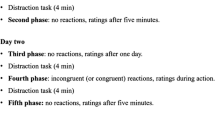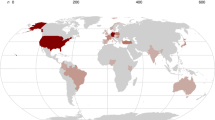Abstract
Support for the weak version of the facial feedback hypothesis has been obtained repeatedly with the dynamic pose paradigm. In contrast, support for the strong version, which is tested with the static pose paradigm, has been inconsistent. We attributed this to methodological limitations in some studies rather than to problems intrinsic to the static pose paradigm. Utilizing a methodology that improved upon the hypothesized limitations, we obtained the facial feedback effect for the static poses of joy and anger with 142 male undergraduate students. The effect was uniform across levels of stimulus intensity and stimulus affect. Facial feedback did not vary with skills in nonverbal affective communication, self-monitoring, and the ability to form mental images.
Similar content being viewed by others
References
Buck, R. (1980). Nonverbal behavior and the theory of emotion: The facial feedback hypothesis.Journal of Personality and Social Psychology, 38 811–824.
Cochran, W. G. (1941). The distribution of the largest of a set of estimated variances as a fraction of their total.Annals of Eugenics, 11 47–52.
Colby, C. Z., Lanzetta, J. T., & Kleck, R. E. (1977). Effects of expression of pain on autonomic and pain tolerance responses to subject-controlled pain.Psychophysiology, 14 537–540.
Cupchik, G., & Leventhal, H. (1974). Consistency between expressive behavior and the evaluation of stimuli: The role of sex and self-observation.Journal of Personality and Social Psychology, 30 429–442.
Duncan, J., & Laird, J. D. (1977). Cross-modality consistencies in individual differences in self-attribution.Journal of Personality, 45 191–206.
Duncan, J., & Laird, J. D. (1980). Positive and reverse placebo effects as a function of differences in cues used in self-perception.Journal of Personality and Social Psychology, 39 1024–1036.
Ekman, P., & Friesen, W. V. (1975a).Unmasking the face. Englewood Cliffs, New Jersey: Prentice Hall.
Ekman, P., & Friesen, W. V. (1975b).Facial expression slides. Palo Alto, California: Consulting Psychologists Press. (Slides)
Ekman, P., Levenson, R. W., & Friesen, W. V. (1983). Autonomic nervous system activity distinguishes among emotions.Science, 221 1208–1210.
Friedman, H. S., Prince, L. M., Riggio, R. E., & DiMatteo, M. R. (1980). Understanding and assessing nonverbal expressiveness: The Affective Communication Test.Journal of Personality and Social Psychology, 39 333–351.
Hager, J. C., & Ekman, P. (1981). Methodological problems in Tourangeau and Ellsworth's study of facial expression and experience of emotion.Journal of Personality and Social Psychology, 40 358–362.
Izard, C. E. (1977).Human emotions. New York: Plenum Press.
Izard, C. E. (1981). Differential emotions theory and the facial feedback hypothesis of emotion activation: Comments on Tourangeau and Ellsworth's “The role of facial response in the experience of emotion.”Journal of Personality and Social Psychology, 40 350–354.
Izard, C. E., Doughterty, F. E., Bloxom, B. M., & Kotsch, W. E. (1974).The Differential Emotions Scale: A method of measuring the subjective experience of discrete emotions. Unpublished manuscript, Vanderbilt University.
Kleck, R. E., Vaughan, R. C., Cartwright-Smith, J., Vaughan, K. B., Colby, C. Z., & Lanzetta, J. T. (1976). Effects of being observed on expressive, subjective, and physiological responses to painful stimuli.Journal of Personality and Social Psychology, 34 1211–1218.
Kleinke, C. L., & Walton, J. H. (1982). Influence of reinforced smiling on affective responses in an interview.Journal of Personality and Social Psychology, 42 557–565.
Kotsch, W. E., Izard, C. E., & Walker, S. G. (1978).Experimenter-manipulated patterning of the facial musculature and the experience of emotion. Unpublished manuscript, Vanderbilt University.
Kraut, R. E. (1982). Social presence, facial feedback, and emotion.Journal of Personality and Social Psychology, 42 853–863.
Laird, J. D. (1974). Self-attribution of emotion: The effects of expressive behavior on the quality of emotional experience.Journal of Personality and Social Psychology, 29 475–486.
Laird, J. D. (1984). The real role of facial response in the experience of emotion: A reply to Tourangeau and Ellsworth, and others.Journal of Personality and Social Psychology, 47 909–917.
Laird, J. D., & Crosby, M. (1974). Individual differences in self-attribution of emotion. In H. London & R. Nisbett (Eds.),Cognitive alteration of feeling states. Chicago: Aldine-Atherton.
Laird, J. D., Wagener, J. J., Halal, M., & Szegda, M. (1982). Remembering what you feel: Effects of emotion on memory.Journal of Personality and Social Psychology, 42 646–657.
Lanzetta, J. T., Cartwright-Smith, J., & Kleck, R. E. (1976). Effects of nonverbal dissimulation on emotional experience and autonomic arousal.Journal of Personality and Social Psychology, 33 354–370.
Leventhal, H., & Mace, W. (1970). The effect of laughter on evaluation of a slapstick movie.Journal of Personality, 38 16–30.
McArthur, L. Z., Solomon, M. R., & Jaffe, R. H. (1980). Weight differences in emotional responsiveness to proprioceptive and pictorial stimuli.Journal of Personality and Social Psychology, 39 308–319.
McCaul, K. D., Holmes, D. S., & Solmon, S. (1982). Voluntary expressive changes and emotion.Journal of Personality and Social Psychology, 42 145–152.
Sheehan, P. W. (1967). A shortened form of Betts' questionnaire upon mental imagery.Journal of Clinical Psychology, 23 386–389.
Snyder, M. (1974). Self-monitoring of expressive behavior.Journal of Personality and Social Psychology, 30 526–537.
Tourangeau, R., & Ellsworth, P. C. (1979). The role of facial response in the experience of emotion.Journal of Personality and Social Psychology, 37 1519–1531.
Zuckerman, M., Klorman, R., Larrance, D. T., & Spiegel, N. H. (1981). Facial, autonomic, and subjective components of emotion: The facial feedback hypothesis versus the externalizer-internalizer distinction.Journal of Personality and Social Psychology, 41 929–944.
Author information
Authors and Affiliations
Additional information
This article is based on a thesis submitted by the first author to California State University, Long Beach, in partial fulfillment of the requirements for the M.A. degree. The second author was chair of the thesis committee. John Jung and Robert W. Kapche were members of the thesis committee; their contributions to the thesis are gratefully acknowledged. The first author is currently enrolled in the Ph.D. program in clinical-community psychology at the University of South Carolina, Columbia, South Carolina 29108. This work was described in a paper presented at the meeting of the Western Psychological Association, Sacramento, April 1982.
Rights and permissions
About this article
Cite this article
Rutledge, L.L., Hupka, R.B. The facial feedback hypothesis: Methodological concerns and new supporting evidence. Motiv Emot 9, 219–240 (1985). https://doi.org/10.1007/BF00991829
Issue Date:
DOI: https://doi.org/10.1007/BF00991829




